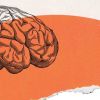
Looking across the animal kingdom, you see animals with different senses who therefore experience the world differently. If you are a blind bat, your whole world is pieced together from echolocation. If you are a tick, you can only sense body odor and temperature. If you are a black ghost knifefish, your world is defined by perturbations in electrical fields. It is presumably quite different to be one of these animals than it is to be a human, because each species constructs the world out of different sensory material.
This holds true even when we compare humans to one another. Given that we all have unique genes and experiences, each of us is the sole inhabitant of our own planet, like Matt Damon’s character in the 2015 movie The Martian. We communicate across planets to one another with a thin bandwidth of language. We say, “Doesn’t this fish taste delicious?” or “Doesn’t that painting look beautiful?” but we never know what the experience is like in another person’s mind. Your perception is a function of your genetics and every life experience you’ve ever had. These make you who you are.
I’ve long wondered how different animals perceive time. It is difficult to study. I have hypothesized that our perception of time relates to how far in the past our experience extends, so if you are a small animal like a hummingbird, it doesn’t take long for information to travel from the tips of your wings to your little brain. I suspect that hummingbirds live closer to the present than an elephant, who must wait for a signal from its back foot to move up a long spinal cord to the brain. If an elephant wants a unified conscious perception of what is happening around it, it must wait to collect all the information, meaning it lives further in the past.
About the Contributor
David Eagleman is a neuroscientist and New York Times bestselling author of Incognito: The Secret Lives of the Brain and Sum: Tales from the Afterlives. He is the writer and host of the Emmy-nominated PBS television series The Brain. Eagleman is an adjunct professor at Stanford University, a Guggenheim fellow, and the director of the Center for Science and Law.





